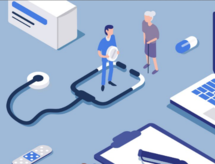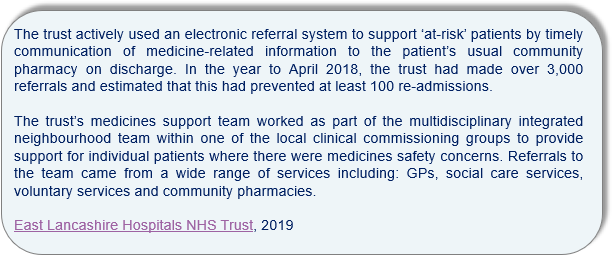Medicines in health and adult social care
Today, 6 June 2019, we have published a report sharing the learning from risks and good practice in medicines optimisation, which we have found on our inspections.
Many of the services that CQC regulates have a role in managing medicines. Through inspection, we have seen that medicines can present a clear risk to people when not used properly.
When CQC inspects health and care services we assess how well they meed people's needs. As part of this, we look at how people's medicines are optimised. Medicines optimisation is the safe and effective use of medicines to enable the best possible outcomes for people. It also looks at the value that medicines deliver, making sure that they are both clinically and cost effective, and that people get the right choice of medicines, at the right time, with clinicians engaging them in the process.
We do this through a dedicated team of pharmacy professionals who work across the country providing specialist advice on the use of medicines in all settings. This includes being on site at inspections, inputting into decisions on enforcement and supporting CQC's policy teams.
From our analysis, we have categorised the most common areas of risk with medicines across regulated health and adult social care services. You can read these in more detail, along with our suggested actions for all health and social care providers, in the main report.

The report also examines what a number of these themes mean in the context of acute hospitals. These include prescribing errors, capacity of pharmacy services and high-risk medicines such as anticoagulants and insulin.
We explore some of these themes in more detail below, along with examples of good practice, but you can jump straight to the acute hospitals section of the report by clicking from the contents section of the main report.

Prescribing and administration
The single most common theme from our analysis of notifications was prescribing errors. Notifications consistently reported incidents where prescribers had made an error that resulted in patients receiving the wrong medicine, the wrong dose, medicines that interact with each other, or no medicines at all.
We also found some good examples of using both simple, practical measures and more advanced technology to reduce medicines administration errors in acute trusts. You can find these in the main report.
|


Pharmacy capacity and skill mix
The capacity of pharmacy staffing is a crucial consideration for the acute setting. We found insufficient pharmacy resource was a concern for both NHS and independent hospitals.
The lack of capacity that we found meant that medicines reconciliation was not happening after admission to hospital, either within the recommended 24-hour timeframe, or at all. This was a factor in both NHS and independent services.
Acute providers should also ensure that relevant staff are receiving appropriate training to administer or review medicines to ensure that people are kept safe. The ongoing competency of staff should also be assessed, particularly following incidents.
The role of medication safety officer (MSO) is central to working towards safer use of medicines in a hospital. One of the key responsibilities for MSOs is ownership of reporting medicines incidents, which involves improving reporting rates and promoting learning among staff. By giving this role higher prominence within a trust, boards can be aware of issues and track progress on medicines safety.
|


Transfer of care
Problems with the supply of medicines and how information is transferred put people at increased risk of harm when they change from one healthcare setting to another. We highlighted this in our report Beyond barriers, which looked at how well services work together to support and care for people aged 65 and over with complex and long-term needs.
We identified 108 out of the 600 incidents analysed occurred at the point when the patient was discharged or transferred to the care of another service.
We also saw that people became unwell because their medicines were not managed properly when they were waiting for transfer between hospitals. An important aspect of the discharge process is that people are appropriately assessed to ensure they can safely take their own medicines. This did not always happen and resulted in re-admission to hospital.
|

Actions for acute hospital providers
Based on the risks identified with medicines use in acute hospital settings, we encourage providers to take the following action to ensure that medicines are managed safely:
- The role of medication safety officer is crucial to the oversight and responsibility for safety, particularly regarding prescribing, monitoring and administration of high-risk medicines, including insulin. This role should have higher recognition at board level. By providing updates on areas of concern from a medicines safety officer, a trust’s board can be aware of issues and track progress on medicines safety.
- To reduce the risk of drug allergy, prescription and medicines administration records (paper or electronic) should be standardised to allow easy recording of allergies and adverse drug reactions, in line with NICE guidance.
- When patients are discharged from hospital electronic information systems need to transfer details relating to medicines accurately and in good time. Staff in hospitals and other services need to work collaboratively at this crucial stage to improve how information is transferred. There is an opportunity to share collective learning from errors and system failures.
Did this bulletin work for you?
|